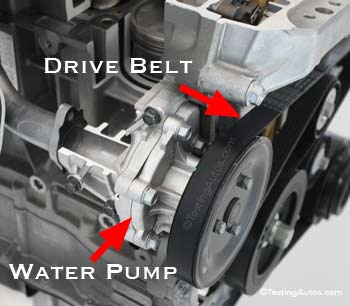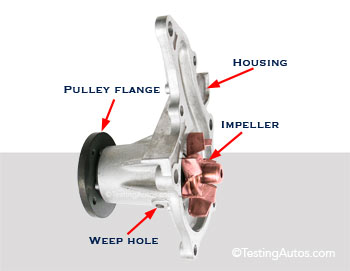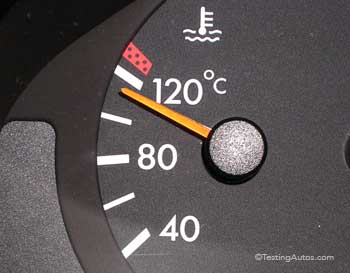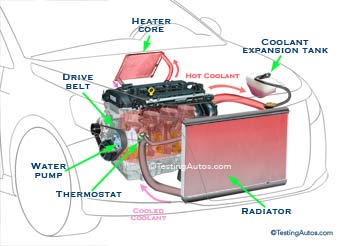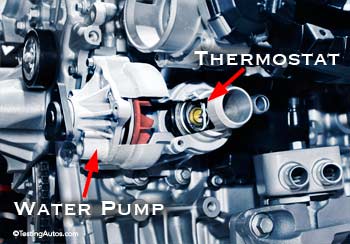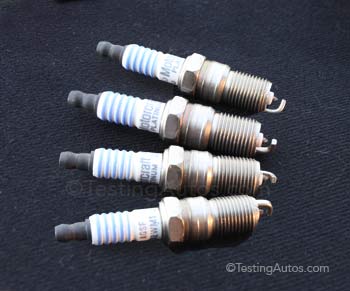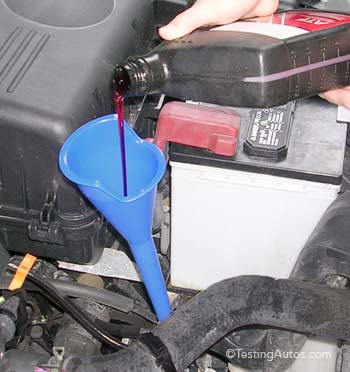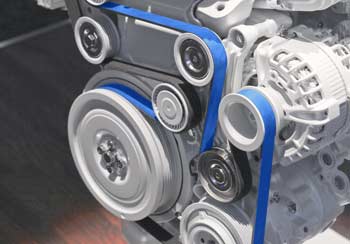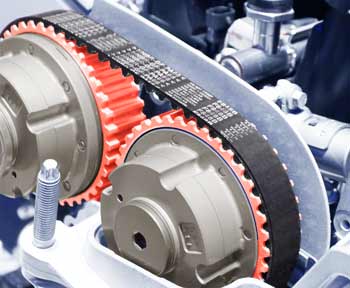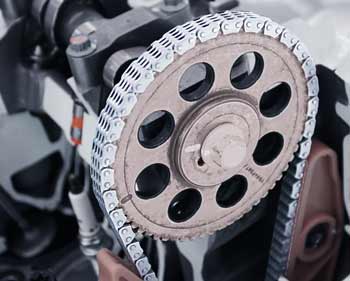When does the water pump need to be replaced?
Updated: May 22, 2020
The water pump circulates liquid coolant within the cooling system of a car engine; see the diagram and read more on how it works below. It's called a water pump because in the early days of automobiles engine cooling systems were filled with water. Modern cars use a special fluid called antifreeze or coolant.
A working water pump is vital for the engine; if the water pump doesn't work, the engine will overheat. A modern car engine can survive mild overheating, but severe overheating can damage it.
When does the water pump need to be replaced? The water pump doesn't need to be changed in regular mileage intervals. It must be inspected during regular services and replaced if it's bad or shows early signs of failing. In some cases a water pump is replaced as a precaution; for example, when changing the timing belt, or when it's suspected to cause overheating or in cars that are known for water pump failures. In an average car a water pump lasts for 100,000-150,000 miles, although it can fail prematurely.
What are the signs of a failing water pump?
Leaks: One of the early signs is a coolant leak from the water pump. The water pump has a weep (bleed) hole in the lower portion; see the photo. A small amount of dry coolant residue around the weep hole is normal, but coolant leaking from the weep hole is a sign that the pump is on its way. Car makers provide guidelines for mechanics on when a water pump is considered bad and needs replacing. Sometimes coolant may seep from the pump seal or O-ring. A coolant leak from the pump usually shows as a pinkish or greenish residue, depending on the color of the coolant. Often, leaking coolant is splashed by a drive belt, and it looks like a whitish residue around the drive belt and surrounding area.Noises: In some vehicles, a failing water pump can cause grinding or rumbling noises; sometimes intermittent. In cases like this, a mechanic will have to diagnose the source of the noise, before condemning the water pump. For example, a mechanic may find that the water pump shaft is loose, which means the pump is bad.
Replacing a water pump with a timing belt/chain:
If a water pump is driven by the timing belt, it is often replaced as a precaution during the timing belt replacement. The reason is that it takes only a little extra labor to replace a water pump when doing the timing belt because it's in the same location.Is it necessary to replace a water pump with a timing belt? No, but it's an option worth considering. For example, if you check an owners manual for one of the Honda vehicles with a V6 engine, it says "Replace timing belt and inspect water pump." Many Honda owners, however, opt to replace the water pump together with the timing belt because if the water pump fails later it will cost the same labor to replace. Plus, a water pump is not a very expensive part ($45-$170).
For the same reason, if a water pump is driven by a timing chain, a mechanic may recommend replacing it as a precaution if some work is done with the timing chain or in the same area. Again, it's not necessary, but it will be a lot more expensive replacing it later, since many parts will have to come off to get to the water pump.
If the engine has been overheated because of a broken water pump, there is always a chance that it might have suffered some other damage as a result. It all depends on the severity of overheating. However, a mechanic may not be able to check for further engine damage until the water pump is replaced and the engine is started. In cases like this, your mechanic may recommend considering all options before doing repairs.
Water pump replacement cost
The labor cost depends on the location. In most cars, a water pump is bolted to the engine from the outside and is not very difficult to replace.Advertisement
In some cars, the water pump is installed inside the engine. For example, changing the water pump in the 2007-2014 Ford Edge V6 engine might cost over $2,000, since the water pump is inside the engine and is driven by a timing chain.
Often, parts like a thermostat or a drive belt are replaced together with a water pump. These parts are not very expensive.
After the water pump is replaced, the cooling system must be bled properly to remove air pockets from the system. Air pockets can prevent the flow of coolant through the system. One of the signs of air pockets in the cooling system is when there is no heat from the vents at idle with the heater on and the engine running. Another sign is when the temperature gauge shows erratic readings. Normally, the heater should provide good heat at any engine speed.
How the engine cooling system works:
The cooling system of a car engine circulates liquid coolant between the engine and the radiator where excess heat is dissipated into the air passing through radiator fins. The water pump delivers the flow of coolant through the system.How the engine cooling system works: Let's look at this diagram. The thermostat closes the circulation through the radiator when the engine is cold, so the water pump circulates the coolant within the engine and through the heater core. The heater core provides heat for the heating system. When the engine reaches normal operating temperature, the thermostat opens, allowing the flow of hot coolant through the radiator. As the hot coolant passes down through the radiator, it cools down. The water pump draws the cooled coolant back out of the radiator and into the engine. In the majority of today's cars, a water pump is a mechanical device rotated by a drive belt. The drive belt itself is driven by the crankshaft pulley of the engine. In some cars, a water pump is driven by a timing belt or timing chain. Other cars have an electric water pump that is operated by an electric motor.
